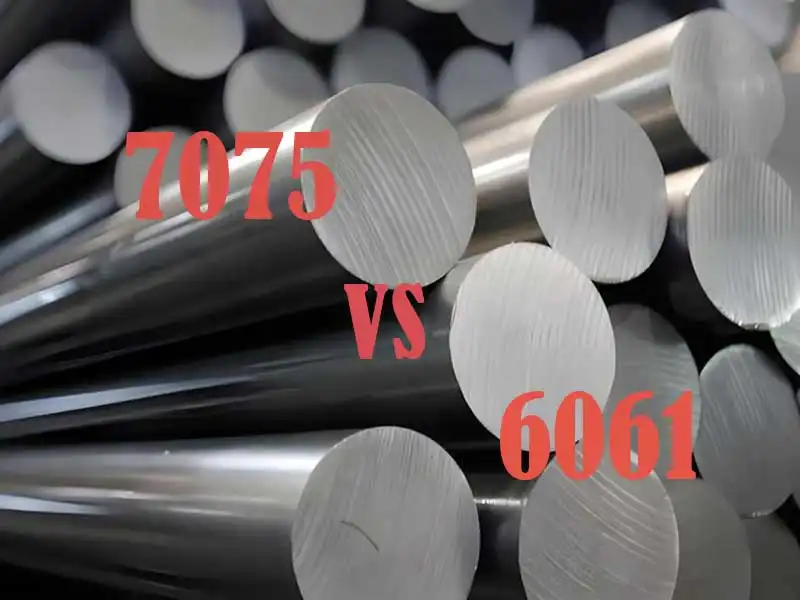Aluminium alloys are among the most widely used materials in modern engineering, owing to their excellent strength-to-weight ratio, corrosion resistance, and formability. Among them, 7075 aluminium and 6061 aluminium are two of the most commonly specified grades for structural and industrial applications.
This article provides a systematic comparison between 7075 and 6061 aluminium alloys, covering their chemical composition, mechanical properties, corrosion resistance, machinability, cost, and typical applications, to support engineers and designers in making informed material selection decisions.

Overview of Aluminium Alloys
Aluminium Alloy Classification
Aluminium alloys are broadly classified into wrought (deformable) and casting alloys, and further categorized by series:
- 6xxx series: Al-Mg-Si alloys (e.g., 6061)
- 7xxx series: Al-Zn-Mg-Cu alloys (e.g., 7075)
Each series offers distinct combinations of mechanical and corrosion properties, tailored to specific industrial requirements.
7075 Aluminium Alloy
7075 is a high-strength, heat-treatable wrought aluminium alloy primarily alloyed with zinc, magnesium, and copper. It is standardized under specifications such as ASTM B209 and EN AW-7075. This alloy is renowned for its exceptional strength and is widely used in aerospace and defense applications.
6061 Aluminium Alloy
6061 is a medium-strength, heat-treatable aluminium alloy alloyed with magnesium and silicon, conforming to standards like ASTM B209 and EN AW-6061. It is recognized for its excellent corrosion resistance, good weldability, and versatile mechanical properties, making it suitable for a broad range of structural and industrial uses.
Chemical Composition Comparison
Major Alloying Elements
| Element | 7075 (% by weight) | 6061 (% by weight) |
|---|---|---|
| Aluminium (Al) | Balance | Balance |
| Zinc (Zn) | 5.1 – 6.1 | ≤ 0.25 |
| Magnesium (Mg) | 2.1 – 2.9 | 0.8 – 1.2 |
| Copper (Cu) | 1.2 – 2.0 | 0.15 – 0.40 |
| Chromium (Cr) | 0.18 – 0.28 | 0.04 – 0.35 |
| Silicon (Si) | ≤ 0.4 | 0.4 – 0.8 |
| Iron (Fe) | ≤ 0.5 | ≤ 0.7 |
Influence of Composition
The high zinc and copper content of 7075 contributes to its superior strength, but also reduces its corrosion resistance compared to 6061. In contrast, the balanced magnesium and silicon content of 6061 results in good corrosion resistance and excellent weldability, albeit with lower strength than 7075.
Properties Comparison
Mechanical Properties
- 7075: Ultimate tensile strength ~ 510–570 MPa (T6), yield strength ~ 430–500 MPa, hardness ~ 150–160 HB.
- 6061: Ultimate tensile strength ~ 290–310 MPa (T6), yield strength ~ 240 MPa, hardness ~ 95 HB.
Corrosion Resistance
6061 exhibits superior resistance to atmospheric and marine environments, while 7075 is more prone to stress corrosion cracking and pitting, particularly in saltwater conditions.
Machinability and Weldability
- Machinability: Both alloys offer good machinability, with 7075 being slightly harder to machine due to its higher strength.
- Weldability: 6061 is highly weldable with standard techniques; 7075 is generally considered non-weldable due to its susceptibility to cracking.
Thermal Properties
6061 has better thermal conductivity and can withstand higher temperatures under load compared to 7075.
Density
Both alloys have comparable densities: ~2.8 g/cm³, with negligible differences for most engineering calculations.
Cost and Availability
7075 is more expensive due to its alloying elements and processing requirements. In addition, it is less commonly available in certain forms compared to 6061, which is widely produced in a variety of shapes and tempers.
Applications of 7075 Vs 6061 Aluminium Alloys
Applications of 7075 Aluminium Alloy
- Aerospace structural components (wings, fuselage frames)
- Military equipment (firearms, armored vehicles)
- High-performance sports equipment (bicycle frames, climbing gear)
- Precision tooling and moulds
Applications of 6061 Aluminium Alloy
- Architectural structures, curtain walls, pipelines
- Automotive and railway components
- Marine fittings and boat hulls
- General-purpose industrial machinery parts
- Applications requiring excellent corrosion resistance and weldability
Selection Guide
When selecting between 7075 and 6061, engineers should consider:
- Required strength: 7075 is preferable for maximum strength.
- Corrosion resistance and weldability: 6061 is superior in corrosive environments and when welding is necessary.
- Cost constraints: 6061 is more economical.
- Fabrication processes: 6061 is easier to form and weld.
| Property | 7075 | 6061 |
|---|---|---|
| Strength | ★★★★★ | ★★★ |
| Corrosion Resistance | ★★ | ★★★★ |
| Weldability | ★ | ★★★★★ |
| Cost | $$$$ | $$ |
Conclusion
Both 7075 and 6061 aluminium alloys have distinct advantages that make them suitable for different engineering applications. While 7075 offers exceptional strength, it comes at the expense of corrosion resistance, weldability, and cost. Conversely, 6061 provides a balanced combination of strength, corrosion resistance, and workability, at a lower cost. Engineers should evaluate the specific performance requirements, environmental conditions, and budgetary constraints before making a material selection.
Frequently Asked Questions (FAQ)
Q1: Which alloy is easier to weld?
A: 6061 is much easier to weld than 7075.
Q2: Is 7075 worth the higher cost?
A: If maximum strength in a critical application justifies the cost and corrosion can be mitigated, then 7075 is an excellent choice.
Q3: Which alloy is better for outdoor use?
A: 6061 is generally preferable in outdoor and marine environments due to its superior corrosion resistance.


